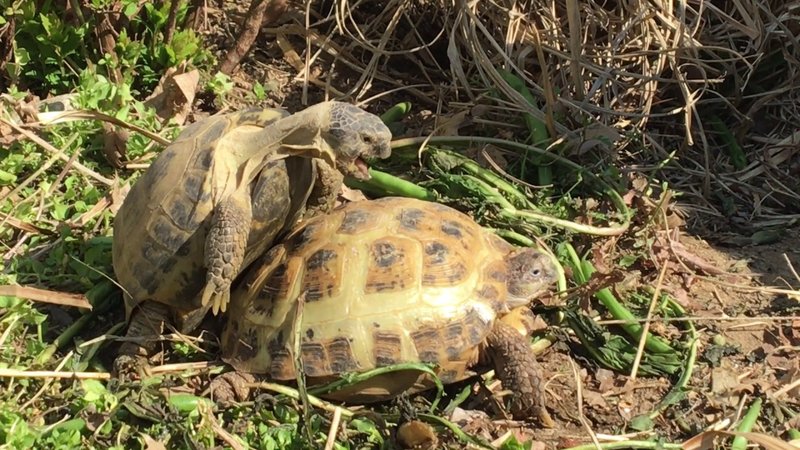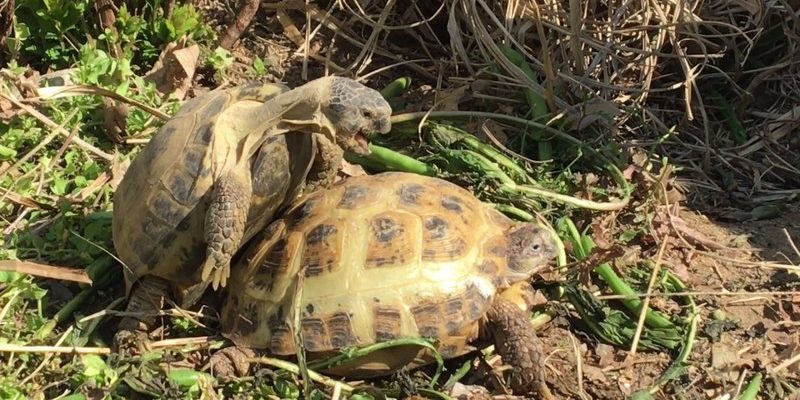
The Russian tortoise, known scientifically as *Testudo horsfieldii*, is a small but charming species that mainly inhabits the grasslands and scrublands of Central Asia. They’re popular pets due to their manageable size and docile nature, but they carry a lot of interesting reproductive behaviors that can be quite intriguing to explore. So, let’s dive into the captivating world of Russian tortoise reproduction—after all, there’s more to these critters than their adorable faces!
Understanding the Mating Rituals
When it comes to mating, Russian tortoises have some unique courtship behaviors. Typically, males display noticeable signs of interest that can, at times, appear a bit aggressive. You might see them bobbing their heads up and down, which is a way of showing off their strength and readiness to mate. Think of it as a display of confidence at a dance party—everyone wants to impress!
During the spring months, when temperatures start rising, males become especially active. They might chase females for several minutes, sometimes even ramming into them gently to get their attention. This behavior can often escalate into a sort of playful wrestling match. Male tortoises will often climb onto the backs of females, which can look a bit clumsy but is part of the mating process.
It’s essential to ensure that if you have a pair of Russian tortoises, they have enough space to interact safely. Too cramped, and you might notice stress or aggressive behavior that you don’t want. Honestly, watching these tortoises interact can provide a glimpse into their personalities and social structures.
The Importance of the Breeding Season
Breeding season for Russian tortoises typically occurs from late March through June. This timing aligns with warmer weather, which is crucial because these reptiles rely on external temperatures for mating. You might be wondering why that’s important. Well, tortoises are ectothermic, meaning they need heat from their environment to become active.
During this period, the female’s reproductive hormones increase, and she becomes more receptive to mating. It’s fascinating to think of how instinctively they know when conditions are just right for breeding. The warmth signals them that spring is in full swing, providing the right setting for raising young ones.
Once a successful mating has occurred, it’s not immediately clear how many eggs a female will lay. Typically, a Russian tortoise might produce between 3 to 8 eggs per clutch, depending on her age and health. This variability is another layer of what makes their reproductive cycle so intriguing.
Nesting: Where the Magic Happens
After mating, the next step in the reproductive cycle is nesting. Female Russian tortoises are quite selective when it comes to finding the perfect spot to lay their eggs. They tend to prefer sandy or loose soil, which provides adequate warmth and humidity for the developing embryos. You can think of it as searching for the perfect cozy nook for a nap.
When the time comes to lay eggs, the female will dig a nest using her back legs. This process can take anywhere from 30 minutes to several hours, as she meticulously creates a space that feels just right. Once she lays her eggs, she’ll cover them up with soil again, hiding them from potential predators.
It’s essential to ensure that captive females have a suitable nesting area. If they can’t find a proper spot, they may become stressed or even attempt to lay eggs in inappropriate places, which isn’t ideal. Creating a safe and comfortable environment for breeding is crucial to ensuring their reproductive success.
The Incubation Process
After laying the eggs, the incubation begins. In the wild, the temperature and humidity of the nesting site are critical factors in determining whether the eggs will develop successfully. Typically, Russian tortoise eggs take about 60 to 90 days to incubate under natural conditions.
Interestingly, the temperature during incubation can affect the gender of the hatchlings. Warmer temperatures tend to produce more females, while cooler conditions might result in more males. It’s a natural balancing act that ensures both sexes are represented in the population.
If you’re incubating eggs in a controlled environment, like an incubator, it’s essential to monitor the conditions closely. The right balance of warmth, humidity, and airflow can significantly impact the hatch rates. A successful hatch can be an incredibly rewarding experience, filled with little tortoise hatchlings peeking out from their shells.
Challenges and Considerations
While breeding Russian tortoises can be a rewarding endeavor, it does come with its challenges. One common issue is that not every female will successfully mate or produce viable eggs. Factors such as age, health, and environmental conditions can all play a role.
Additionally, if you’re keeping multiple tortoises together, you may need to monitor their interactions closely. Sometimes, males can become overly aggressive, which can lead to injuries for the females or stress-related health issues. Providing plenty of space and hideaways can help ease tensions.
Another consideration is the potential for overbreeding. If you’re not prepared for the responsibility of caring for baby tortoises (also known as hatchlings), it’s essential to think carefully before breeding. Each hatchling will need a suitable habitat, diet, and care to thrive.
Breeding and reproductive behavior of the Russian tortoise is a complex and beautiful process that showcases the wonders of nature. By understanding their mating rituals, nesting habits, and incubation needs, you can appreciate these creatures even more. Whether you’re a budding tortoise enthusiast or just curious about animal behavior, witnessing the cycle of life in these gentle reptiles can be truly captivating.
Remember, if you decide to breed Russian tortoises, it’s essential to remain informed and responsible. With the right setup and knowledge, you can create a nurturing environment for both adult tortoises and hatchlings. This cycle of life is not just about survival; it’s about understanding the delicate balance that keeps these remarkable creatures thriving.

